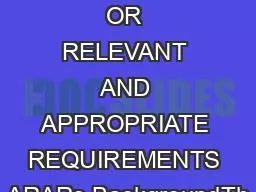

substance pollutant or contaminant that will remain onsite if i any standard requirement criteria orlimitation under any Federal environmental law or ii any promulgated standard requirement or limitat ID: 895033
Download Pdf The PPT/PDF document "APPLICABLE OR RELEVANT AND APPROPRIATE R..." is the property of its rightful owner. Permission is granted to download and print the materials on this web site for personal, non-commercial use only, and to display it on your personal computer provided you do not modify the materials and that you retain all copyright notices contained in the materials. By downloading content from our website, you accept the terms of this agreement.
1 APPLICABLE OR RELEVANT AND APPROPRIATE R
APPLICABLE OR RELEVANT AND APPROPRIATE REQUIREMENTS (ARARs) BackgroundThe requirement for identifying ARARs is established in Section 121 (d)(2)(A) of the Comprehensive Environmental Response, Compensation and Liability Act of 1980, as amended (CERCLA substance, pollutant or contaminant that will remain onsite, if (i) any standard, requirement, criteria, orlimitation under any Federal environmental law...; or (ii) any promulgated standard, requirement, or limitation under a State environmental or siting law that is more stringent than any Federal standard, requirement, criteria, or limitation ... and that h This section of CERCLA describes the process and standards to be used for selecting remedial actions at sites subject to CERCLA. Substantive requirements are either directly applicable or pulledfrom other regulatory programs (including state statutes) where they may be relevant to the circumstances. Ohio law does not include a parallel ARAR process; however, the Division of Emergency and Remedial Response’s (DERR) , 40 CFR, Part 300). Therefore, in order tomaintain consistency with the NCP, Ohio EPA follows the federal ARARs process. To view a list that includes state statutes and click here . Determining ARARs In the Remedial Response ProgramApplicable or relevant and appropriate requirements are those substantive requirements that pertain directly to actions or conditions at the site. A requirement is applicable if the Applicable or relevant and appropriate requirements can be statutory or regulatory and are not limited to Ohio EPA statutes or rules. For example, Ohio Department of Natural Resources (ODNR) establishes requirements f
2 or reclamation of surface mined areas.
or reclamation of surface mined areas. The practices of soil conservation and drainage control used for surface mines are relevant and appropriate to the large soil borrow areas that provide the soil used to cover landfills in DERR remedial sites. ODNR also has regulations for the construction of dams and levees that may be relevant and appropriate for DERR sites that involve containment of waste along riverbanks.The following definitions are found in Section 300.5 of the NCP.Applicable Requirementsare defined as: Those cleanup standards, standards of control, and other substantive requirements, criteria, or limitations promulgated under federal environmental or state environmental or facility siting laws that specifically address a hazardous substance, pollutant, contaminant, remedial action, location, or other circumstance at a CERCLA site.Relevant and Appropriate Requirementsare defined as: Those cleanup standards, standards of control, and other substantive requirements, criteria, or limitations promulgated under federal environmental or state environmental or facility siting laws that, while not “applicable” to the hazardous substance, pollutant, contaminant, remedial action, location, or other circumstance at a CERCLA site, address problems or situations sufficiently similar to those encountered at the CERCLA site that their use is well suited to the particular site.As discussed in the NCP at 55 FR 8741 (3/8/90), ARARs fall into three categories. ChemicalSpecific: These rules define permissible concentrations of chemicals for various environmental media, such as soil or ground water. They are generally based on health or risk based
3 criteria. Some apply statewide while oth
criteria. Some apply statewide while others are based on sitespecific calculations. Such quantities as the maximum contaminant levels (MCLs) for drinking water would be chemical specific ARARs. Calculated surface water discharge limits would be another ARAR of the chemicalspecific type. ActionSpecific: These rules specify how a remedial alternative must be achieved. They are generally technologybased and apply to specific remedial approaches rather than to a site. An example of an actionspecific ARAR would be the design specifications for a landfill cap. Construction of a cap may be one of several possible actions that could be selected for a remedial site. However, if indeed a cap was selected as the remedy, it ould have to be constructed according to the Agency’s rules for caps at solid waste landfills. If another technique, such as land treatment was the remedy, it would also have to be implemented according to the relevant rules. LocationSpecific: These rules may require or restrict particular actions because of the site location, even if the same actions were acceptable elsewhere. An example is the location of a new solid or hazardous waste disposal cell constructed as a part of a remedial action. Such a cell would not be allowed over a high yield aquifer or adjacent to a water way. Another locationspecific set of ARARs are the rules pertaining to jurisdictional wetlands. Those rules might impose the requirement for development of supplemental wetlands to compensate for those destroyed either by the original contamination or through the remedial activities. These same actions outside a wetland would impose no such requirements